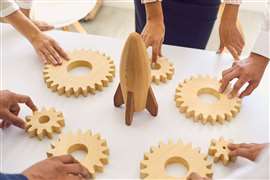Interview: Terex AWP
28 May 2019
There are changes afoot at Genie following parent company Terex’s recent sale of its crane products - all of them complementary, company president Matt Fearon tells Euan Youdale.
Bauma, Monday morning, 11:00. It’s the start of the world’s biggest construction show and expectations are heightened, as Matt Fearon, the president of Terex AWP, finds time amid the bustle at Genie’s booth to explain the latest happenings at the company.
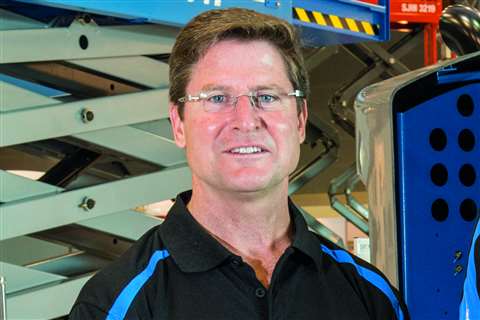
And, there have been a few, thanks to parent company Terex Corporation’s announcement in February that it will sell its Demag Mobile Cranes business. It includes discontinuing its mobile crane production lines at its Oklahoma City facility, a move that is set to benefit Genie greatly. As part of the reorganisation, Terex Utilities will become part of Terex AWP, which includes the Genie brand. The Oklahoma City facility will also join Terex AWP, focusing on telehandlers, aerial re-manufacturing and various products for the Materials Processing division of the company.
The Demag Mobile Cranes business sale, which is subject to government regulatory approvals and other customary closing conditions, is expected to close in mid-2019. More recently it was announced that Terex had also sold its boom truck, truck crane and crossover product lines to Load King, a subsidiary of Custom Truck One Source. Included in the transaction are the assets and parts business associated with these products.
Expanding on what this all means for Terex AWP, Matt Fearon said, “We have picked up a couple of meaningful businesses. The biggest piece is the Terex Utility business, the insulated lift structures, truck mounted and digger derricks. They used to be under Genie about 10 years ago, so it fits perfectly.”
With the additions, Genie becomes around a $3billion revenue company. “The reality is Genie has always been a significant part of Terex’s revenue and operating profit and with the potential selling off of the cranes business that is definitely getting bigger.”
Utilities is run by its general manager Clint Weber. He helped set up Genie’s China factory in Changzhou and before that was based at the brand’s US facility in Redmond, Washington. “I am very familiar with him, and I am going to leave that as a standalone business but it’s a perfect bolt-on because its primarily aerials and we share some operations in China and we will continue to do that. So, there’s lots of overlap between the two businesses.”
Another advantage comes with the service network that Utilities has across North America, which over the last decade has provided some Genie servicing too. “What you will see is that we will start to use that footprint to offer more service to customers. We are excited by that as there are not enough service technicians in the industry.”
Shared goals
As far as the shared Oklahoma facility is concerned, Genie has been making its North American telehandlers there since 2014. Genie also has its certified used equipment programme at the plant, including refurbishment, and an engineering team. There is also a standalone training centre, with capacity for 50 trainees.
“And now the cranes are moving out, it gives us a perfect location for the North American market,” explains Fearon, “For telehandlers, it is driven by oil & gas, so it’s quick to get into Texas and quick to go straight up into Canada.
“It was a bit dated, but we upgraded the facility. That work is already done and with all our product development, it fits perfectly.”
Looking to the future, Genie still produces some of its telehandlers for the North American market in Italy. With the extra space in Oklahoma they could easily move there. “Plus, we have a lot of new products coming out and if we are going to hit the peak of the replacement cycle, we have got some space. The paint systems are in place, so it’s really exciting.”
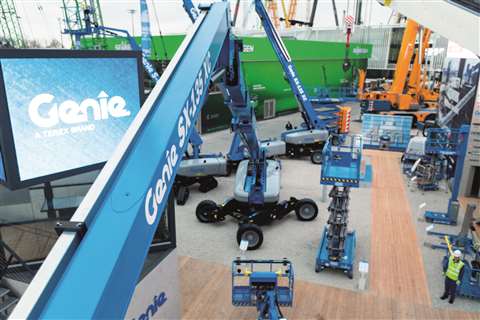
Fearon says Genie is constantly assessing its global footprint, with a view not just to expansion but logistics and the reallocation of activities as required. “When your supply chain is changing, logistics is a major piece of it. So, we are constantly looking at the footprint. Oklahoma gives us a big open spot on the chessboard to move things around.”
And Utilities is expanding too at its current base in Watertown, South Dakota, thanks to the largest capital expenditure programme at Terex Corp., amounting to a new factory, with 11 buildings being combined into one.
Are there any plans to expand the Utilities segment globally? “The market in China for live line work is one that, like everything, is growing the fastest, so we definitely see some expansion,” Fearon answers. And there are wider opportunities when it comes to lifts on trucks. “Obviously, truck mounts are a huge part of the aerial market, whether you talk about Europe or if you look at Japan.”
This also applies to non-insulated products. “Genie has got a lot of experience in non-insulated boom structures; they [Utilities] have great experience on mounting on trucks. So, we will continue to look at what opportunities come up.”
In fact, the worldwide opportunities for Terex AWP as a whole are considerable. “Over the years we have put a lot of energy into globalising the Genie business. But we are still very North American centralised. A lot of our sales are in North America, and we continuously try and push into developing markets. We will use the whole portfolio to expand.”
Being geographically close to the customer is a key factor when driving into new markets. “The closer you are to the customer the faster you can react to demands. That’s the starting point but we have to look at the cost. “The other piece, which will be harder for people to see, is that the supply chain is moving”. For example, some of the components that were being supplied from China are starting to be provided from elsewhere. A good reason for this lies in the recent and well-documented trade tariffs in the US. “Who knows what is going to happen with these tariffs but we’ve got a large Terex sourcing initiative. We have been talking to suppliers all over the world and we have a good idea who has the capability and capacity to supply us.”
Global footprint
The company recently announced that it is again expanding its factory in China, and the footprint in Italy has grown too. “And we have our eyes on other parts of the world. We start with ‘local for local’, and then, as we get capability, we look at what is the most economical way to do it.
“Some products lend themselves to being put in containers much more efficiently than others. You can pack containers tightly and start to be pretty competitive. We know that we have competitors all over the world trying to come in and pick apart what we have, so we are not going to just sit back and live off the code we had in the past; we continue evolve.”
All this forward planning would seem to contradict any idea of Terex AWP following the same path as the crane division. Indeed, Fearon is adamant that Terex AWP will not be sold. “There are no plans to sell off Genie.”
Nevertheless, there are the inevitable concerns. “Team members ask me; they are worried about it. I tell them, even if there was going to be someone who was going to come and buy it, they would want us to perform exactly like we are doing, pay attention to customers and keep working on product innovations. But there are no plans.
“[Terex CEO] John Garrison’s view is very clear, his strategy is: Simplify, and Execute to Win. He has been trimming the portfolio back where he thinks it is best for the company. So, no, there are no plans to sell off Genie.”
Expanding on the sale of the crane products, he adds, “For us, there is very little disruption at all; we know what we have to do and we are completely focused on it.”
Moving on to the company’s expansion strategy, Fearon says future growth will be organic, rather than there being any specific plans for acquisition. “We see enough opportunity with organic growth. When you look at the overseas potential in aerials, there is a lot of organic growth and that is where we are focused right now. “We have success with the international markets. We got in there early, about 25 years ago, so we have a good installed base.
“We feel that we have put the hard years in developing those markets and we are making sure we have the aftermarket support to grow it. In tandem, we have the manufacturing presence, a large successful factory in China.”
The third phase of China factory expansion will mean the company can produce its entire scissor family and most boom products in that part of the world. On the subject of emerging markets, Fearon adds, “They sometimes start out with a distributor model, then evolve to rental, so in the vast majority of our large markets we are setting up our own distribution centres, having local teams in the right time zones that speak the local language.
Beyond China, India is the next market that Genie is keeping a close eye on. “Aerials are starting to be accepted more there. The rest of the markets are fairly mature.”
Another potentially huge market, Latin America is becoming a little brighter. “They have been the slowest to come out of the recession – or they had their own one – but it seems like it is starting to perk up.”
In the biggest market of them all, North America, the aforementioned tariffs are proving a real challenge for any company requiring large amounts of steel. It started in 2018 with the threat of tariffs, triggering US steal producers to raise prices significantly, on both plate and coil. “It was not the tariff on anything coming into the country, it was the US steel companies pushing their prices up.
“Then, in July when some of the tariffs started to hit, the components we were buying from overseas, China, were getting hit with a 25% tariff, so absolutely, it has hit the cost of machines.”
Rather than sitting back and hoping for the best, Genie is working with its supply partners to find solutions, although this strategy can take time. “So, in the short term we definitely saw an increase in our input cost but the supply chain has reacted quickly and we already had a sourcing initiate in Terex. The timing was perfect because we had been out in the market looking at the suppliers for the last 24 months.”
He adds, “We are starting to get our arms around how many things are going to be tariffed. Because, you have things that you buy directly from suppliers and then there are the other components that our suppliers are buying sub-assemblies into.
“We have had to set up teams that are watching exactly what is going on and tracking it back. Some of it you can claw back; we are figuring out how to do that.”
Certainly, the cost cannot be passed on to the customer. “We pass some on, but only so much – the market sets the price.”
Another factor in the modern marketplace is consolidation. Mergers and acquisitions are nothing new but there has been a flurry of activity in both Europe and North America over the last couple of years, and Fearon believes that is set to continue.
“The market is changing. It [consolidation]started in North America but now you can see it in Europe. The large rental houses are good operators and what they do is scalable. They are using that to their advantage; it’s a good way for them to continue to grow.
“They know exactly how and where they make money, so it raises the bar for us as manufacturers; it pushes us, which, I think, is good. A lot of them we have had relationships with for decades, so we can work with them on a larger scale - we just need to make sure we are keeping up.”
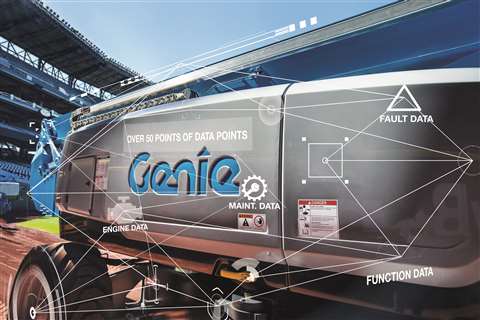
A key development in today’s rental model is an ever more sophisticated use of data. Genie’s answer to that is its recently-launched Lift Connect telematics solution, which the company is placing as standard on all booms, scissors and telehandlers. It will come with three years subscription for the data, then customers can renew it over the following years.
The requirements will be different, depending on the rental outfit. “There are the large consolidators, but then there are the smaller rental companies. They often don’t have the infrastructure to put in the required IT systems, so we want to offer a service to them. We are trying to help them both out.”
The nub of the matter lies in actional information. “You can put sensors all over these machines, you can get so much information off them and in time we will get more. But you have to be able to connect it to them making money; extending the life of their fleet, avoiding a service call. Otherwise it is just too much information and it overwhelms everyone.”
Today’s requirements go way beyond the basics of GPS machine location and whether it is on or off. “There is some really low hanging fruit and we are just making sure we are able to get to that fruit. Some of that fruit lies in battery management data, including the health of the battery and its charge status. It’s also a huge opportunity to solve the service shortage problem.
“In the life of a scissor lift, if you can stop one service call a year, that matters, and it’s easy to imagine stopping way more than that. The financial return for the rental companies is going to be significant.”
Over time even more will be understood about the life of a machine. “How much load is going in the machine, how many times a year does it actually go up and down? It will allow us to optimise the design of the machines and work with our supply chain and say, ‘hey, your component is only lasting this number of hours’.
“And, think what it will be like 10 years from now. I think everyone should be excited about it. It will make the machines better and the businesses are going to be easier to run.”
Over the next decade it is also likely the conundrum over who owns the data - the supplier or the customer - will be resolved. “My view is that we should both be able to share the data. And, if there is data that, for some reason, they don’t want us to know about, we can scramble that and not look at it. If you have a pragmatic approach, there are very few that won’t work with you on it.”
Equipment trends
If that wasn’t enough, the equipment is changing too, particularly in the direction of electric and hybrid-powered equipment. At Bauma, Genie launched its second hybrid FE boom and electric drive scissor.
Designed using the same hybrid technology as its higher lifting Genie Z-60 FE (formerly Z-60/37 FE) sister model, the new Genie Z-45 FE boom lift offers a maximum working height of 15.92m a maximum horizontal outreach of 6.94m, a maximum up-and-over reach of 7.50m and 300kg maximum lift capacity.
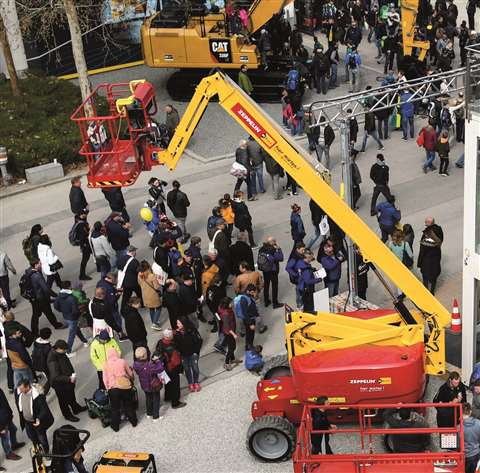
“It is a true indoor, outdoor, cold weather, 4-wheel drive machine. Its performance is as good or better than a 4-wheel drive diesel,” explains Fearon.
“We are looking at the energy that the machine is using and making sure we have a very efficient drive system in there and making sure we are getting the most out of it without compromising any of the performance.”
“We are excited about the technology, but we are also excited about the second use of the machine – the engine is a rest of the world engine.”
Its bigger brother, the Z-60FE was launched three years ago, and according to Fearon have been delivered all over the world. “They are accepted. And they are accepted in places like North America, which was not really pushing for hybrids but once they get their hands on them they love them, and they realise that there are some benefits there.”
Fearon adds, “Also, you are seeing electric drive on our smallest scissors and our biggest electric scissor and we have the Lithium batteries showing [here at Bauma]. So, you can kind of connect the dots. There is a movement, especially in Europe, for these types of products - they are leading it.”
Eventually the electric trend will move to big booms, but there are hurdles to overcome before they become a viable option for serial production. “The bigger the machine gets, the heavier it gets and the more batteries they need to move them, so it’s really going to come down to charging. If they go to a different job site every other month, will there be the infrastructure there to plug them in and are they able to operate in cold temperatures?”
“The bigger booms are definitely going to be the ones where it goes a little later but you will see it continue to move up that way.”
On the subject of Lithium batteries, Fearon believes the time is right for this power source. “Everything about them is better, apart from the cost. So, you have to look at the cost across the life of the machine. Lead acid batteries get replaced about every three years and in the life of a machine it is getting three sets of batteries. But if you just look at the performance of these batteries, the charge time, everything about them we believe is better. The real trick is getting them to perform in the cold; you can’t have a Lithium battery without a good management system and a heater. There are some technical hurdles that need to be overcome but it’s right around the corner.”
Financial future
Turning Genie’s financial results, the Terex AWP business segment reported a slow start to the year in its first quarter of 2019. However, that followed a very strong 2018 financial year, overall. Speaking before the release of the 2019 first quarter figures, Fearon says access’ biggest market North America has seen significant growth in recent times.
“If you look at 2017 and 2018, they were big years. I expect it might level off a little, but we don’t see a major turndown in 2019. It feels like its slowing down but if it levels off, then it levels off at a very high number of machines going into the market.”
A slowdown could come as a result of better fleet management by the rental companies. “It goes back to what I said earlier. They are getting so good at managing their fleets they won’t overrun. A decade ago they may have kept going. So, I think it’s healthy for the industry if it slows down a little and it doesn’t get to be this big bubble that just pops.”
Europe, as ever is mixed, says Fearon, “There is the Brexit cloud, no one is quite sure what they should be doing. That holds some areas back, but Europe is good. It has been steady over the last couple of years and has a nice growth rate.”
China, on the other hand is booming, yet is still a relatively small proportion of the Genie business and amounts to a single digit percentage of sales. “It’s still in single digits but it grows at the highest rate of anywhere. Some of the figures I don’t know that I agree with, but I see our own figures and the growth rate is the strongest of anywhere in the world.”
As Fearon says, the addition of Utilities makes Terex AWP a $3 billion business, and that figure is set to rise. “It’s safe to say we may go through a little softening in North America in 2019 but I don’t think it will be a significant dip. And as you go five years from now, we see significant growth.”




